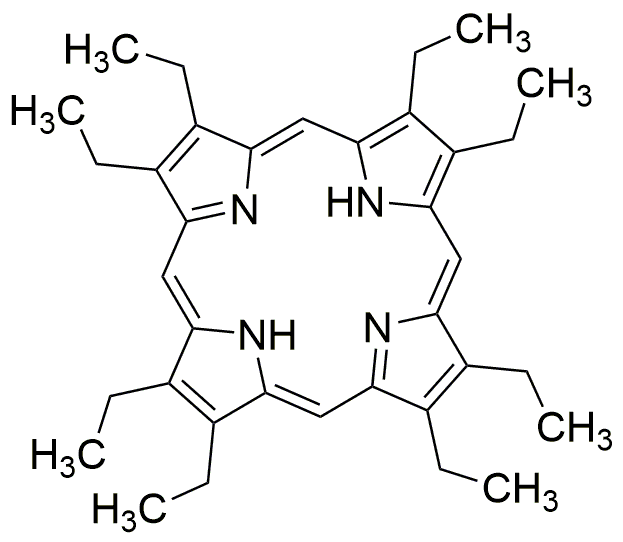2,3,7,8,12,13,17,18-Octaethylporphyrin is widely utilized in research focused on:
- Photodynamic Therapy: This compound is used in cancer treatment, where it acts as a photosensitizer. When exposed to light, it generates reactive oxygen species that can destroy cancer cells, making it a valuable tool in targeted therapy.
- Solar Energy Conversion: Its unique structure allows it to efficiently absorb sunlight, making it an excellent candidate for use in solar cells. Researchers are exploring its potential to enhance the efficiency of photovoltaic devices.
- Biochemical Sensors: The compound can be incorporated into sensors for detecting various biomolecules. Its ability to change properties in response to environmental changes makes it useful in medical diagnostics and environmental monitoring.
- Organic Electronics: It is being studied for applications in organic light-emitting diodes (OLEDs) and organic photovoltaics, where its electronic properties can improve device performance and stability.
- Catalysis: The compound shows promise as a catalyst in various chemical reactions, particularly in organic synthesis. Its unique porphyrin structure can facilitate reactions that are challenging with traditional catalysts.
Informations générales
Propriétés
Sécurité et réglementation
Applications
2,3,7,8,12,13,17,18-Octaethylporphyrin is widely utilized in research focused on:
- Photodynamic Therapy: This compound is used in cancer treatment, where it acts as a photosensitizer. When exposed to light, it generates reactive oxygen species that can destroy cancer cells, making it a valuable tool in targeted therapy.
- Solar Energy Conversion: Its unique structure allows it to efficiently absorb sunlight, making it an excellent candidate for use in solar cells. Researchers are exploring its potential to enhance the efficiency of photovoltaic devices.
- Biochemical Sensors: The compound can be incorporated into sensors for detecting various biomolecules. Its ability to change properties in response to environmental changes makes it useful in medical diagnostics and environmental monitoring.
- Organic Electronics: It is being studied for applications in organic light-emitting diodes (OLEDs) and organic photovoltaics, where its electronic properties can improve device performance and stability.
- Catalysis: The compound shows promise as a catalyst in various chemical reactions, particularly in organic synthesis. Its unique porphyrin structure can facilitate reactions that are challenging with traditional catalysts.
Documents
Fiches de données de sécurité (FDS)
La FDS fournit des informations de sécurité complètes sur la manipulation, le stockage et l’élimination du produit.
Spécifications du produit (PS)
Le PS fournit une description complète des propriétés du produit, notamment sa composition chimique, son état physique, sa pureté et les exigences de stockage. Il détaille également les plages de qualité acceptables et les applications prévues du produit.
Certificats d'analyse (COA)
Recherchez des certificats d'analyse (COA) en saisissant le numéro de lot du produit. Les numéros de lot et de lot se trouvent sur l'étiquette d'un produit, après les mots « Lot » ou « Lot de fabrication ».
Numéro de catalogue
Numéro de lot/série
Certificats d'origine (COO)
Ce certificat d'exploitation confirme le pays dans lequel le produit a été fabriqué, et détaille également les matériaux et composants utilisés et s'il est issu de sources naturelles, synthétiques ou autres sources spécifiques. Ce certificat peut être requis pour les douanes, le commerce et la conformité réglementaire.
Numéro de catalogue
Numéro de lot/série
Fiches de données de sécurité (FDS)
La FDS fournit des informations de sécurité complètes sur la manipulation, le stockage et l’élimination du produit.
DownloadSpécifications du produit (PS)
Le PS fournit une description complète des propriétés du produit, notamment sa composition chimique, son état physique, sa pureté et les exigences de stockage. Il détaille également les plages de qualité acceptables et les applications prévues du produit.
DownloadCertificats d'analyse (COA)
Recherchez des certificats d'analyse (COA) en saisissant le numéro de lot du produit. Les numéros de lot et de lot se trouvent sur l'étiquette d'un produit, après les mots « Lot » ou « Lot de fabrication ».
Numéro de catalogue
Numéro de lot/série
Certificats d'origine (COO)
Ce certificat d'exploitation confirme le pays dans lequel le produit a été fabriqué, et détaille également les matériaux et composants utilisés et s'il est issu de sources naturelles, synthétiques ou autres sources spécifiques. Ce certificat peut être requis pour les douanes, le commerce et la conformité réglementaire.


